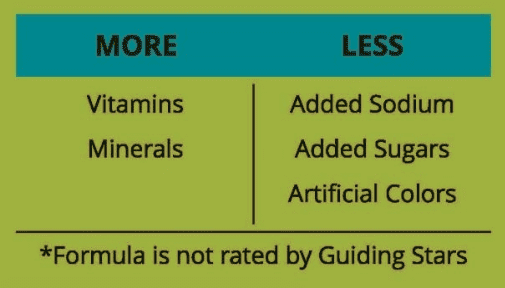
Starting solid foods is an exciting milestone for babies, but it can seem complicated and confusing for parents. For the first 4-6 months, the feeding choice was between breast milk and formula. Now, the options are multiplied and in a variety of innovative forms like biscuits, juices, pouches, puffs, purees, and yogurts (even freeze-dried). On top of that, parents are likely receiving conflicting advice on what is best for baby (whether they ask for it or not) from family, friends, and healthcare providers. Well, Guiding Stars is here to help with nutrition guidance you can trust.
Our Scientific Advisors created an objective algorithm that uniquely addresses the needs of babies to assist parents in selecting nutritious foods for baby’s first bites. In this edition of Surprising Stars, we will address how Guiding Stars evaluates baby and toddler foods.
The Guiding Stars algorithm for babies and toddlers reflects the specific nutritional requirements of children under the age of two. By selecting baby foods with one, two, or three stars, you’ll be feeding baby more vitamins and minerals and less added sodium, added sugar, and artificial colors.

Approximately 85% of baby and toddler foods in our database earn Guiding Stars. The more stars, the more nutritious a choice is. You can search for the star rating of baby and toddler foods here.
Why are there no stars on baby formula?
Major medical authorities in the United States heavily regulate baby formula, resulting in uniformity across brands. We also recognize that leading pediatric authorities recommend breastfeeding for the first six months of a child’s life and beyond if mom and child are agreeable. We do not want our rating system to cause confusion.
Adult foods are debited if they have saturated fat, why not baby foods?
There are no recommended daily fat intakes for children from birth to age two. Children in this age group are in a period of rapid growth and development that is characterized by high nutritional requirements, including fat requirements to support optimal development of their nervous system.
In the dairy section, whole milk does not earn stars, but aren’t young children supposed to drink whole milk?
Milk is rated using recommendations for children over the age of two and adults. For children under the age of two, the American Academy of Pediatrics recommends that breastfeeding continue to the age of 12 months, and thereafter as long as mutually desired. Babies need fat in their diets for a variety of reasons, including neurological development. Toddlers should drink whole milk from ages 1 to 2 years; then, if their growth is steady, they can be switched to low-fat or skim milk.
Why don’t you credit baby foods with fiber?
There is no recommended daily intake of dietary fiber for babies 6 to 12 months of age. Until the age of 2 years, fiber is not a nutrient of emphasis. The Dietary Guidelines, which recommend fiber-rich foods, are specifically for individuals older than 2 years of age.
One thing to note: our Scientific Advisors look forward to the release of the 2020-2025 Dietary Guidelines, which will include recommendations for children between the ages of birth to 24 months for the first time.
Why do some fruit juices earn Guiding Stars?
Guiding Stars ratings align with consensus recommendations from leading health organizations on what young children should be drinking. Parents, and all shoppers, will find star-earning 100% fruit choices. However, we advise that children under the age of 12 months should avoid all juice and children between the age of 12-24 months should drink no more than ½ cup (4 ounces) of 100% fruit juice per day.
If you’re interested in learning more on what infants and toddler need in their diets, we have a webinar available here.